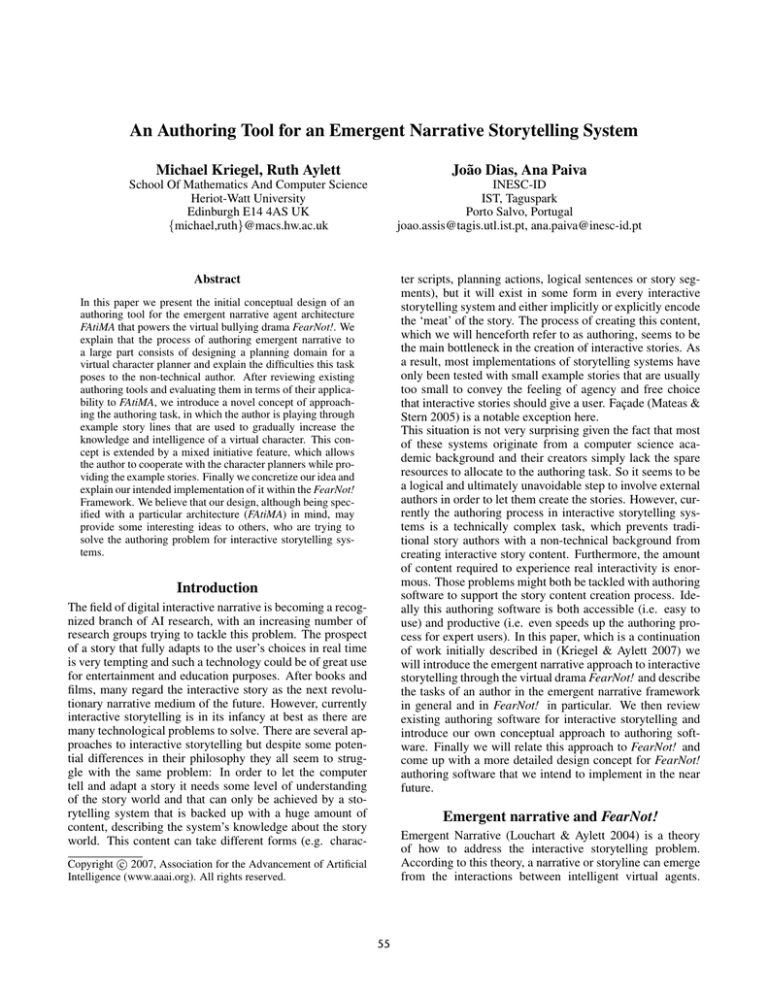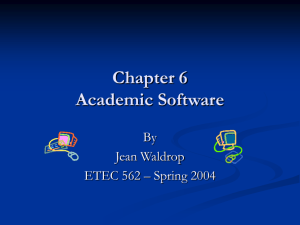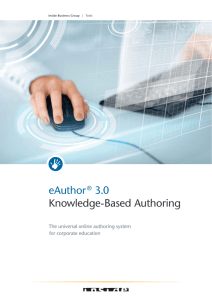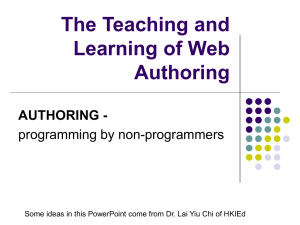
An Authoring Tool for an Emergent Narrative Storytelling System
Michael Kriegel, Ruth Aylett
João Dias, Ana Paiva
School Of Mathematics And Computer Science
Heriot-Watt University
Edinburgh E14 4AS UK
{michael,ruth}@macs.hw.ac.uk
INESC-ID
IST, Taguspark
Porto Salvo, Portugal
joao.assis@tagis.utl.ist.pt, ana.paiva@inesc-id.pt
ter scripts, planning actions, logical sentences or story segments), but it will exist in some form in every interactive
storytelling system and either implicitly or explicitly encode
the ‘meat’ of the story. The process of creating this content,
which we will henceforth refer to as authoring, seems to be
the main bottleneck in the creation of interactive stories. As
a result, most implementations of storytelling systems have
only been tested with small example stories that are usually
too small to convey the feeling of agency and free choice
that interactive stories should give a user. Façade (Mateas &
Stern 2005) is a notable exception here.
This situation is not very surprising given the fact that most
of these systems originate from a computer science academic background and their creators simply lack the spare
resources to allocate to the authoring task. So it seems to be
a logical and ultimately unavoidable step to involve external
authors in order to let them create the stories. However, currently the authoring process in interactive storytelling systems is a technically complex task, which prevents traditional story authors with a non-technical background from
creating interactive story content. Furthermore, the amount
of content required to experience real interactivity is enormous. Those problems might both be tackled with authoring
software to support the story content creation process. Ideally this authoring software is both accessible (i.e. easy to
use) and productive (i.e. even speeds up the authoring process for expert users). In this paper, which is a continuation
of work initially described in (Kriegel & Aylett 2007) we
will introduce the emergent narrative approach to interactive
storytelling through the virtual drama FearNot! and describe
the tasks of an author in the emergent narrative framework
in general and in FearNot! in particular. We then review
existing authoring software for interactive storytelling and
introduce our own conceptual approach to authoring software. Finally we will relate this approach to FearNot! and
come up with a more detailed design concept for FearNot!
authoring software that we intend to implement in the near
future.
Abstract
In this paper we present the initial conceptual design of an
authoring tool for the emergent narrative agent architecture
FAtiMA that powers the virtual bullying drama FearNot!. We
explain that the process of authoring emergent narrative to
a large part consists of designing a planning domain for a
virtual character planner and explain the difficulties this task
poses to the non-technical author. After reviewing existing
authoring tools and evaluating them in terms of their applicability to FAtiMA, we introduce a novel concept of approaching the authoring task, in which the author is playing through
example story lines that are used to gradually increase the
knowledge and intelligence of a virtual character. This concept is extended by a mixed initiative feature, which allows
the author to cooperate with the character planners while providing the example stories. Finally we concretize our idea and
explain our intended implementation of it within the FearNot!
Framework. We believe that our design, although being specified with a particular architecture (FAtiMA) in mind, may
provide some interesting ideas to others, who are trying to
solve the authoring problem for interactive storytelling systems.
Introduction
The field of digital interactive narrative is becoming a recognized branch of AI research, with an increasing number of
research groups trying to tackle this problem. The prospect
of a story that fully adapts to the user’s choices in real time
is very tempting and such a technology could be of great use
for entertainment and education purposes. After books and
films, many regard the interactive story as the next revolutionary narrative medium of the future. However, currently
interactive storytelling is in its infancy at best as there are
many technological problems to solve. There are several approaches to interactive storytelling but despite some potential differences in their philosophy they all seem to struggle with the same problem: In order to let the computer
tell and adapt a story it needs some level of understanding
of the story world and that can only be achieved by a storytelling system that is backed up with a huge amount of
content, describing the system’s knowledge about the story
world. This content can take different forms (e.g. charac-
Emergent narrative and FearNot!
Emergent Narrative (Louchart & Aylett 2004) is a theory
of how to address the interactive storytelling problem.
According to this theory, a narrative or storyline can emerge
from the interactions between intelligent virtual agents.
c 2007, Association for the Advancement of Artificial
Copyright Intelligence (www.aaai.org). All rights reserved.
55
Those agents are autonomous, intelligent and emotional.
Implementation-wise that means that each agent is an
individually running program that includes a continuous
planner. Unlike other storytelling approaches where a story
is planned, in emergent narrative only agent behavior is
planned. That means characters do not take commands
from a higher level entity and do not directly follow a plot.
This way character believability is maximized since they
will not carry out actions that help advance the plot but are
not in character. Instead an author has to ensure that the
characters are configured in such a way that they exhibit
the intended behavior for the anticipated story. It is thus
the author’s main task to configure the planners that drive
the agent’s behavior. A good way to understand the main
philosophy behind emergent narrative is to look at real life
role-playing games (RPGs, live action or pen & paper).
Players are briefed in advance of the game session in order
to make sure they understand their character’s role in the
world. Once the game starts no one restricts their freedom
of decision making. The game master can influence the
course of the story by influencing the environment and
action outcomes, but he has no direct control over the
decisions of the player. In emergent narrative the agents
are let loose in a similar way as the players in an RPG. The
author’s task of configuring the agents is then analogous to
briefing the players of an RPG.
generic goal of inviting a friend to a party. It is activated if
the agent is hosting a party and sees someone he likes, who
is not invited yet. In this situation it will create an instantiated intention to invite that agent by replacing the unbound
variable [friend] with the agent’s name. The goal will succeed if the invited agent replies positively and will fail if the
agent replies negatively. The action represents the generic
Question action, which has the precondition of not asking a
question to yourself and has the effects of getting a negative
or positive answer. This action can be used by the planner
to achieve the invite goal by replacing the unbound variables
[question] and [target] by values that match the goal’s success conditions.
The emergent narrative concept described above could
be implemented in many different ways. We will now
quickly describe its implementation within the educational
anti-bullying application FearNot! (Aylett, Dias, & Paiva
2006). In FearNot! small groups of agents representing
school children interact within a virtual school environment.
Each of those agents runs a separate instance of the agent
mind software FAtiMA. FAtiMA incorporates two levels, a
deliberative level that controls the agent’s goal-oriented behavior and is built upon an emotional continuous planner,
and the reactive level which defines a set of fast-activation
rules that allow the agent to experience an emotion and react very quickly. FAtiMA’s emotion system is based on the
OCC emotion theory (Ortony, Clore, & Collins 1988).
The deliberative layer is also responsible for the generation of OCC’s prospect based emotions (e.g. Hope, Fear,
Satisfaction). These emotions are triggered by the state of
plans and goals in memory. For instance, if the plan that the
agent is considering is likely to succeed the agent will feel
hope. But if the plan then fails, it will feel disappointment.
These emotions are then used to influence the coping strategies applied to the plans (e.g. if the agent is fearful it might
give up its goal).
Figure 1: example for a goal and action
Reactive level
The reactive level handles both the reactive appraisal of external events and the agent’s reactive behavior. Events are
appraised by the agent using appraisal rules (emotional reactions) provided by the author. These rules define the desirability , the praiseworthiness and desirability for others of
perceived events. These values are then used to create most
of OCC’s emotions. The agent’s reactive behavior is handled by a set of action tendencies. An action tendency represents an unplanned instinctive behavior that is triggered
by an emotion. For example, an agent that is very sad might
start to cry involuntarily. Figure 2 shows an example emotional reaction and action tendency.
The emotional reaction is triggered when anyone refuses
the agent’s party invitation, which is considered undesirable
and a bad action by the agent. The action tendency described is activated (triggers a crying action) whenever there
is an emotion of type distress with an intensity of seven or
more.
Deliberative level
The deliberative level represents the agent’s reasoning process and its intelligence along with its goal directed behavior. On this level the author specifies goals and actions in
a STRIPS like planning language. A goal is represented by
a desired world state (success condition), a forbidden world
state (failure condition) and an activation world state (activation condition) that makes the goal become active, i.e. when
that condition is reached the agent creates an explicit intention to achieve the goal and will start planning for it. An
action on the other hand is represented by its pre conditions
(necessary world state in order to carry out that action) and
effects (changes that this action brings to the world). World
states are annotated using logic formulations. It is possible
to equip an action with variable parameter slots and to access those variables. In Figure 1 the concept is demonstrated
with an exemplary action and goal. The goal describes the
All together, actions, goals, action tendencies and emotional reactions encode almost the complete story content.
56
a few tools designed to allow the creation of lower level
narrative content, for example SWAT, the authoring tool
for Chris Crawford’s storytelling engine Storytron, the
design of which is described in (Crawford 2005). However
in SWAT this more low level control over the involved
narrative elements introduces a complexity which makes the
tools less user friendly for non technical authors. In fact the
authoring approach using for example SWAT is very similar
to programming using a visual programming environment.
Figure 2: example for an emotional reaction and action tendency
Currently all of this needs to be hand coded by an author
using FAtiMA’s XML syntax. It is not hard to see that creating and debugging this kind of data is a tedious task that
could be greatly improved via the use of an authoring tool
and without such could quickly become unmanageable, especially when considering the huge amount of content that
is needed to tell a truly interactive dramatic story.
From our experience in authoringFearNot! the greatest
problem for content authors has been to think more in terms
of characters and less in terms of stories. It seems inevitable
that authors first think about interactive stories in terms of
a variety of possible linear stories, instead of concentrating
only on the characters. Being able to let go of the control of
the story as an author is one of the key concepts that emergent narrative authors need to learn. We will investigate how
authoring software can facilitate this process.
Plan authoring and knowledge engineering tools
Since we are talking about authoring characters that are
driven by planners it is worth having a look at the research
field of AI planning and the tools used to specify planning
domains. Knowledge engineering tools like GIPO (Simpson
et al. 2001) or KANAL (Kim & Blythe 2003) usually offer
some graphical editing of planning domains. They also include other very useful features such as debugging and error
checking. The generated plans can be exported to a planning
language like STRIPS and thus be reused in very different
planning systems. An application to emergent narrative authoring (FearNot! authoring in particular) would be possible. One would only have to provide a piece of software
to translate from the syntax generated by the plan authoring
tool to the syntax used by FearNot! and vice versa. Compared to hand coding this is definitely an improvement, but
since those plan authoring tools are not domain specific, they
will not cover all that is required by the specific domain of
narrative, in case of FearNot! for example the reactive level
of an agent’s mind.
Related work
In this section we review existing narrative authoring, planning and content generation tools in order to identify the
state of the art and to find out whether any of them can be
facilitated in the task of authoring characters, described in
the previous section. It should be clear that there will be
no tool that is directly applicable to our FearNot! domain,
because the FearNot! architecture requires its narrative content to be described in a quite specific way. However, certain
ideas and concepts might be helpful in our task of designing
a FearNot! authoring environment.
Storyboarding tools
Another quite different sort of authoring tools is storyboarding tools. This type of software is very user friendly and easy
to use for non technical authors. The programs Kar2ouche
and Mediastage by the company Immersive Education are
examples of story boarding tools. To varying degrees tools
like this allow an author to easily create or even perform a
story and capture that performance, which can then be used
to demonstrate ideas to other people, just like story boards
are used in the film production process. Storyboarding tools
of course cannot be used to create intelligent characters, but
the user interfaces of those tools are worth paying attention
to, as they are very accessible - and as we argued earlier, that
is one of the key factors, if we want creative authors to start
building interactive story worlds.
Interactive storytelling authoring tools
Other research groups that work on interactive storytelling
have also identified the creation of story content as a serious
bottleneck for the evolution of serious interactive storytelling and have thus worked on authoring tools as well as
storytelling engines. A good overview of the tools available
can be found in (Medler & Magerko 2006). Unfortunately
many tools in this category as for example (Zagalo et al.
2006) or (Sauer et al. 2006) focus on the configuration
of a storytelling environment but not on the creation of
narrative content per se. Those tools are very similar to
the editing software for video games such as Neverwinter
Nights or Warcraft 3. They allow the user to choose and
modify environments for the story, place characters and
objects within the environment and set up basic properties
of those entities. We created a similar tool for FearNot! and
can use it to quickly try different character constellations
in different situations. However, we cannot use it to create
or modify the content of a character’s mind (actions, goals,
emotional reactions and action tendencies). There are also
Authoring by learning
The kind of software that has been reviewed so far is either
too simple or too complex for our intended task. By that, we
mean that the tools that allow to create real narrative content
are very complex and too much like real programming
environments for our intended user group whereas the tools
with an easy user interface only allow superficial content
creation like placing characters and objects in a 3D environment. This might in fact be an inevitable conflict, when we
look at the complexity of the narrative content that we want
57
A suggested authoring environment
to create with the help of those tools. A solution however,
might be an authoring tool with some intelligence that gives
the user an easy interface and adds the required complexity
by employing AI techniques like machine learning. In a
recent interview with the Games For Windows Magazine
Façade creator Michael Mateas said: ”In order to move
toward more radical end-user authoring, the authoring
tools themselves have to start knowing something about
characters and stories, and offer A.I. assistance to the author
to take the bit of authoring they do and multiply the effort.”1
The idea of AI assisted content creation is reflected in the
field of ‘Programming by Example’, which is described in
(Cypher 1993). The idea here is that if a user knows how
to perform a certain task at the computer, instead of writing
a program to solve it, the user can instruct a software to
‘watch what I do’. By observing the user’s actions the
software can then learn to perform those actions itself.
The aforementioned plan authoring tool GIPO also contains
a module that allows the induction of operator descriptions
from examples (McCluskey, Richardson, & Simpson 2002).
By providing examples for solutions to a certain problem
the program can infer the operator (action) descriptions.
Applied to our narrative planning domain this would be
very useful and ease the task of the author. But also in the
field of interactive narrative itself, examples for intelligent
authoring can be found. In Thespian (Si, Marsella, &
Pynadath 2005), a character based storytelling system, the
author can adjust the personality of a character by providing
a set of example stories/scripts that demonstrate how this
character behaves. The software will then automatically
modify certain parameters related to the characters goals, in
order to best match the demonstrated examples.
At the MIT Media Lab, researcher Jeff Orkin has recently
launched a project, entitled The Restaurant2 . In the first
stage of this project a computer game for 2 players was
released, in which one takes the role of the waiter and
the other one that of a guest in a restaurant. Members of
the public were encouraged to play the game online on
the MIT’s servers, with all game sessions being logged.
The project website states that the long term goal of The
Restaurant is to process the logged game sessions with
machine learning algorithms and to use the collected data to
create a single player game, in which the role of waiter or
guest would be taken by a synthetic character.
In our emergent narrative framework the major authoring
task is to create the minds of the intelligent virtual agents.
A substantial part of this task involves configuring the planners that drive the characters, i.e. by specifying the actions
they can perform, the goals they have and the way they react
to events. We are now going to introduce the design of an
application that allows the author to do this as intuitively as
possible.
In a nutshell our proposed authoring environment can be
best described as a rehearsal space for intelligent virtual actors, where the author would take the role of the director.
The author would first set the scene for a rehearsal, by deciding on a setting and placing characters and objects in this
setting. This stage of the authoring process is similar to the
traditional authoring tools and game editors mentioned earlier. Once the scene is set, the author would start a new
rehearsal. During this rehearsal the author controls all participating characters and selects their actions (or inactivity,
if that is desired). We will also adopt the authoring by learning strategy, so for the software itself the rehearsal serves as
learning material to extrapolate data that represents character behavior like new actions or goals. By running through a
number of rehearsals the character’s planning domain would
gradually grow until it is eventually detailed enough to use
the character as an autonomous actor in a virtual drama that
exhibits the desired behavior. Regarding the look and feel
of this authoring environment, games like The Sims but also
the storyboarding tools mentioned earlier provide good examples of effective user interfaces for an application with
our intended purpose.
Mixed initiative
Taking the theater metaphor a bit further, a real theater
director has to engage in discussions with his actors during
rehearsals. In order for the actors to really delve into their
role the director has to communicate his vision of the
character to his actors. Similarly, our system will be able
to build characters much quicker and better if the author
communicates with it. For that purpose we intend to run the
rehearsals in a mixed initiative planning mode. Instead of
merely working with lifeless puppets, the character’s minds
will actually be activated during the rehearsals. Characters
will be able to make decisions and act autonomously in
the rehearsals. This is however, merely a way to assist the
author, who ultimately has the last word on the character’s
actions. At any time the author can override the character’s
planning process and order the character to do something.
This interaction between a human user and an AI planner
is called mixed initiative planning. The idea of applying
this to our field is not entirely new: Although, targeted at
a different system architecture (plot rather than character
based), the work described in (Thomas & Young 2006),
suggests that interactive narrative authoring could benefit
from mixed initiative planning.
Summarizing, this review showed that there are many
different approaches to authoring, which all are useful for
certain purposes. There is no existing solution that solves
our problem of user friendly authoring of an emergent
narrative planing domain, but in our task of creating that
solution, we can draw from all the mentioned work, as we
will show in the next section.
1
Games For Windows Magazine, Issue 6, May 2007, page 34
http://web.media.mit.edu/˜jorkin/
restaurant/
2
58
Communicating the author’s intent
and assess the character’s feelings. Teatrix evaluation
results suggest that the hot seating tool helped the children
in reflecting about the role of the character they play.
In our system, each time the author interferes with the
planner for a character, they will be asked to justify their
actions. That might either happen, when the author orders
the character to carry out an action that the character
would not have come up with itself or if the author cancels
an action that the character would have carried out by
itself. This justification of the author’s actions serves two
purposes: Primarily it is a way for the software to collect
data. Although it is possible for the software to extract
some information from merely observing action sequences,
it will be much more efficient if the actions are backed up
with some background information. Imagine for example
a barkeeper agent. That agent would appear in a number
of stories and it would quickly learn the actions associated
with his role of selling drinks. However from time to time
in a rehearsal the author would cancel the agent’s learned
action of selling a drink to someone who requests it. If
the author has the chance to justify their decision, they
can very quickly teach the barkeeper agent that there are
exceptions to the ‘sell drink’ rule, for example there is no
selling of alcohol to customers that are underage or too
intoxicated. Technically the software could encode those
exceptions for example as pre-conditions of the sell drink
goal. If, however, the author had no way of communicating
their motivation, it would take many rehearsals, before
the software would have collected enough examples of
barkeeper related behavior, to learn those exceptions by
itself. Eventually, with enough examples to observe, it
would still learn this though, so we will not force the author
to justify their actions. Otherwise one could even argue,
that this action justification process is a way to prevent the
software from using machine learning.
The second reason to ask the author for action justification
is that by doing this we force them to think more in terms
of character and less in terms of plot. If an author would
use the same character and let it exhibit radically different
behavior during several rehearsals, the software would
be confused and would confront the author with a lot of
questions about the motivation behind their directing orders.
Hopefully this would help in forming an awareness in
the author about the technical capabilities of the kind of
system they are dealing with. For example it might be a bit
overambitious just yet to model the mind of a schizophrenic
character with the current technologies. The idea that being
forced to justify an actor’s action is facilitating the author’s
reflection process, is backed up by findings of the virtual
Theater project Teatrix (Paiva, Machado, & Prada 2001).
Teatrix is a system that has in fact a lot in common with our
authoring environment. Children take the role of a virtual
character in a collaborative environment. Other children
take the role of other characters while unallocated roles are
filled out by intelligent virtual agents. While a child acts,
the character that is played by the child is also simulated in
the background using an agent model based on Vladimir
Propp’s analysis of the basic plot components of Russian
folk tales. If the actions the child takes diverge too far from
the actions that are suggested by the role, the hot-seating
tool is activated. Here the child has to justify their decisions
Figure 3 summarizes the main authoring method with
included mixed-initiative and action justification features.
Figure 3: main authoring method
As the figure suggests we are not envisioning a real
time application but rather one where the story is divided
into concrete time steps. A new time step would occur
whenever an agent has finished carrying out an action. The
author is in complete control of the time-flow during the
rehearsal. The author decides when to step forward in time
and furthermore will also be able to rewind time, just like
a theater director during a rehearsal could also decide to
restart again, beginning from a certain scene.
Since we are using the theater metaphor quite extensively throughout this paper, it should be made clear at
this point that it only works to a certain degree and should
not be taken too literally. In a real theater environment
the same story is played during each rehearsal. In our
case, the rehearsals need to be different stories or at least
different variants of the same story (although using the same
characters), otherwise there would be no new knowledge
that could be added to the agent minds.
Integrating the authoring method in FearNot!
After we introduced the generic authoring method in the last
section we are now going to explain its application for authoring FearNot! characters, driven by the FAtiMA architecture. Especially we are going to focus on how the different
components of the FAtiMA agent specification as they have
been described earlier (goals, actions, emotional reactions,
action tendencies) can be created.
Graphical presentation
The authoring method we suggested earlier does not necessarily require a 3D authoring environment, but the FearNot!
authoring tool, we are going to create will be using 3D characters in 3D environments for several reasons, the main one
being reusability. The environment in which the rehearsals
take place needs to match the environment in which the
agents will finally perform. Since we already have an integrated 3D graphics engine, a collection of 3D characters
59
and settings and a behavior planner for performing physical
actions in a 3D environment for FearNot!, we should also
use those components during the authoring process. If we
want our characters to perform in a 3D environment later,
we should also train them in a 3D environment. That means
that visually the authoring environment will look similar to
FearNot! (see Figure 4).
but during the authoring process specializations of those actions might be added. Consider for example the basic action Say([speechact],[target]). This action can be used by
the character to say anything to anyone, as [speechact] is a
variable that can be replaced by any speech act and [target]
can be replaced by any character. However, there might be
certain assignments for those variables, when the say action
has special pre conditions and/or effects and in this case a
new specialized action could be created. For example, the
specialized action Say(partyinvitation,[target]) might be a
specific entry in the action library that the agent adds during the authoring process because it learned that this action
has additional specific effects and should only be performed,
when there is a party to invite someone to.
Setting up a new rehearsal
Before a rehearsal can be started, it needs to be set up. In
order to set up a new rehearsal, we need to define the setting,
the characters that are participating and the props involved.
We might also want to predefine certain properties of items
and characters, for example that character A is hungry or
character B is injured. This task very much like defining one
episode for FearNot!. We mentioned earlier that a scenario
authoring tool for FearNot! had already been developed (see
Figure 5) , the main purpose of which is in fact setting up
episodes for FearNot!. With a few modifications we might
be able to adapt this tool to set up a rehearsal instead.
Figure 4: screen shot of FearNot!
Initial state
We will start our discussion by defining the state of the
software, whenever the author starts working on a new set
of characters, i.e. before they start a series of rehearsals.
Since the software cannot know in which direction the characters are going to develop it is desirable that there are no
predefined goals, action tendencies or emotional reactions.
Of course one could also imagine the author choosing one
of several character templates that already contain some
very common behaviors for a certain personality or role,
but for our first design we will not consider that. The more
interesting question is how we treat actions. Since it is
part of our design that the author acts for a character, they
need to be able to select an action from a list of available
actions. Since every action at the mind level needs to have
a correspondent at the physical (i.e. graphical animation)
level, we need to provide a list of available actions, which
is defined by the available animations and other physical
actions in the system. The alternative would be to let the
author create new actions, but in order to do that, they would
also have to define the animation or other physical effect
of this action. It seems more appropriate to use existing
3D graphic design tools to create graphical content such as
animations. The integration of such a component would be
too big a diversion from our goal.
Figure 5: screen shot of the existing scenario authoring tool
for FearNot!
Ordering an action
When the author issues the order to carry out an action to a
character, they will have to specify the reason for that order.
According to the FAtiMA architecture there are really only
two reasons, why an agent performs an action: It is either an
instinctive reaction to an event and/or emotional state (action tendency) or part of a plan to achieve a certain goal. In
the former case, the author will have to define which emotion triggered the action and whether it was just the emotion itself or the emotion coupled with a recent event. This
is enough information for the system to build a new action
That means the basic actions themselves are already part
of the initial state and they are knowledge that every ‘newborn’ agent shares. However, that does not mean that the
action library will not grow and be refined during the authoring process. The initial state contains only basic actions,
60
tendency. In case of an action that is part of a plan, it is
slightly more complicated. Since we start with an empty
goal library, the author will have to name goals during the
authoring process. The author has to specify which goal an
action contributes to. This could be either a new goal (action
is the first step in the plan) or an already active goal. It might
also be possible that by carrying out the action a goal will be
achieved. If this is the case the author also needs to indicate
this. The author should also indicate whenever an action
leads to the failure of any active goal of any character. By
comparing several plans that lead to the same goal’s success
or failure the system can generalize a goal’s pre, success and
failure conditions after a few rehearsals. Additionally to this
required information expert authors can also decide to specify their intent in a more detailed way. For example when
starting a new goal, they could indicate which part of the
current world state was responsible for activating this goal.
The same applies to goal failure and success.
character’s emotional state or a conjunction and/or disjunction involving several of these. We hope that by using a user
friendly interface, which is inspired by the metaphor of a dialog between the agent and the author, this will not become
too complex.
Emotional Reactions
We already have explained how the software can slowly create a library of actions, goals and action tendencies through
several rehearsals. We have not defined yet however how
the emotional reactions of a character are defined. Emotional reactions are very important in the FAtiMA emergent
narrative architecture and they are required to make the story
dynamic but as they reflect a very subtle part of the human
mind, they can hardly be learned by the authoring software
through story observation. That means the author will have
to specify them manually. We should however still think
about ways of how this manual specification can be best integrated within our authoring framework. Emotional reactions are the appraisal rules that define how a character perceives an event and which emotions that triggers in him. FAtiMA expects an emotional reaction to be specified through 3
values: the praiseworthiness (subjective moral judgment of
an action, i.e. was it right or wrong), the desirability (does
the agent like it or not) and the desirability for other agents
involved. Out of these 3 values, several emotions can be
generated according to the OCC (Ortony, Clore, & Collins
1988) emotional model. The best way we found of integrating that into our authoring environment would look something like Figure 6.
Canceling an action
Canceling an action that a character was planning to carry
out is the inverse process of ordering an action. Now the
character specifies why it wants to carry out that action, just
as the author justifies their motivation when ordering an action. The character could either tell the author that the action
is an action tendency or part of a plan. It is now the authors
task, should the character’s justification not please them, to
correct the character. At least the author has to tell the character that the action does not work in a plan toward a certain
goal, that it is not triggered by a certain action tendency or
that it endangers another goal. Again, the author can decide
to help the learning process by being more specific: If the
action was an action tendency the author could specify an
exception, that distinguishes the triggering event from other
events where the action tendency would apply. For actions
that are part of a plan they could specify why a goal cannot
be activated in a certain situation or why this particular action does not lead to the success of a goal as expected by the
character.
Referring to world states
In the previous sections, we have spoken about world states
that the author is referring to, for example to indicate an exception. We earlier mentioned the example of the barkeeper
who should learn not to sell drinks to underage customers.
If the author wanted our agent to learn that exception to the
rule, they would need a way to refer to that particular property (the age of the current customer) as the discriminating
factor. This will probably happen by selecting an entity in
the world (a character or an item) and then selecting the
property from the list of properties this entity possesses. Additionally we must however also consider the possibility that
the discriminating property we would like to refer to is not
part of the world model yet. In our example this would mean
the world model does not include the age of agents as a property. In this case we must allow the author to create the new
property within the authoring tool. Apart from properties,
those distinct world states could also refer to past events, a
Figure 6: a possible way to define emotional reactions
Whenever an event occurs the author could switch to a
mode where symbols would appear above the characters
heads. Those symbols would indicate every character’s
subjective feeling of praiseworthiness(hand)and desirability
(smilies) of the event. The values could be adjusted by the
author. When a character already has an emotional reaction
for a certain event that would be automatically displayed,
so those symbols would also be a good way of displaying
the character’s emotional state during the authoring process.
61
The ‘desirability for other’ value would not have to be additionally specified, since it should be equal to the other
agent’s desirability value.
Kriegel, M., and Aylett, R. 2007. A mixed initiative authoring environment for emergent narrative planning domains.
In Proceedings of the AISB Annual Convention, 453–456.
Louchart, S., and Aylett, R. 2004. Narrative theory and
emergent interactive narrative. Int. J. of Continuing Engineering Education and Life-long Learning 14(6):506–518.
Mateas, M., and Stern, A. 2005. Structuring content in
the facade interactive drama architecture. In Artificial Intelligence and Interactive Digital Entertainment (AIIDE).
AAAI press.
McCluskey, T. L.; Richardson, N. E.; and Simpson, R. M.
2002. An interactive method for inducing operator descriptions. In Proceedings of the 6th International Conference
on AI Planning and Scheduling (AIPS-2002), Toulouse,
France.
Medler, B., and Magerko, B. 2006. Scribe: A tool for
authoring event driven interactive drama. In Technologies for Interactive Digital Storytelling and Entertainment
(TIDSE), 139–150. Springer.
Ortony, A.; Clore, G.; and Collins, A. 1988. The cognitive
structure of emotions. Cambridge University Press.
Paiva, A.; Machado, I.; and Prada, R. 2001. The child
behind the character. special issue on Socially Intelligent
Agents. Editor Dautenhahn, K. - IEEE Systems, Man and
Cybernetics Society 31.
Sauer, S.; Osswald, K.; Wielemans, X.; and Stifter, M.
2006. U-create: Creative authoring tools for edutainment
applications. In Technologies for Interactive Digital Storytelling and Entertainment (TIDSE), 163–168. Springer.
Si, M.; Marsella, S. C.; and Pynadath, D. V. 2005. Thespian: Using multiagent fitting to craft interactive drama.
In Autonomous Agents and Multi Agent Systems (AAMAS),
21–28. IEEE Computer Society.
Simpson, R. M.; McCluskey, T. L.; Zhao, W.; Aylett, R.;
and Doniat, C. 2001. An integrated graphical tool to support knowledge engineering in ai planning. In European
Conference on Planning, Toledo, Spain.
Thomas, J., and Young, R. M. 2006. Author in the loop:
Using mixed-initiative planning to improve interactive narrative. ICAPS 2006 Workshop on AI Planning for Computer Games and Synthetic Characters.
Zagalo, N.; Goebel, S.; Torres, A.; Malkewitz, R.; and
Branco, V. 2006. Inscape: Emotion expression and experience in an authoring environment. In Technologies for Interactive Digital Storytelling and Entertainment (TIDSE),
219–230. Springer.
Conclusion
We think that an authoring tool as described in this paper
could possibly solve the problem of authoring emergent
narratives. Allowing an author to specify content in the form
of linear stories should ease the transition to the different
mindset that is required by emergent narratives. At the same
time by being asked to justify the decisions that a character
makes, the author will be assisted in thinking in terms of
character. Working in a mixed initiative mode, i.e. not
‘switching off’ the characters minds during the rehearsals
will not only help the author in getting a better idea of what
a character has learned during previous rehearsals but also
speed up the authoring process, since obvious and repetitive
actions are taken by the character autonomously, so that the
author can focus on the actions that are new for the character.
Our future work will now focus on the actual implementation of the work described here. We try to approach the
software development using the spiral methodology, which
suggests several iterations of the stages ‘understanding the
requirements’, ‘design’, ‘implementation’ and ‘test’. While
we will soon enter the first ‘implementation’ stage, tests
of the initial prototype system will probably reveal new requirements, which will then have to implemented again. We
will also use tests with the first prototype to decide how we
deal with some more complex questions, for example how
to prevent the software making wrong conclusions or how
to determine how many rehearsals are necessary.
Acknowledgment
This paper is supported by the eCIRCUS (Contract no. IST4-027656-STP) project carried out with the provision of the
European Community in the Framework VI Programme,
and by a scholarship (SFRH BD/19481/2004) granted by
the Fundação para a Ciência e a Tecnologia. The authors
are solely responsible for the content of this publication. It
does not represent the opinion of the European Community
or the Fundação para a Ciência e Tecnologia, which are not
responsible for any use that might be made of data appearing
therein.
References
Aylett, R.; Dias, J.; and Paiva, A. 2006. An affectively driven planner for synthetic characters. In International Conference on Automated Planning and Scheduling
(ICAPS), 2–10. AAAI press.
Crawford, C. 2005. Chris Crawford on interactive storytelling. New Riders.
Cypher, A., ed. 1993. Watch What I Do: Programming by
Demonstration. MIT Press.
Kim, J., and Blythe, J. 2003. Supporting plan authoring and
analysis. In proceedings of the 8th international conference
on Intelligent user interfaces, 109–116.
62








